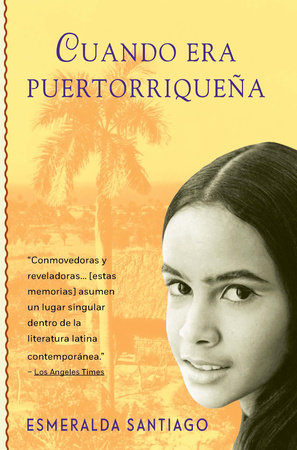Cuando era puertorriqueña / When I Was Puerto Rican Reader’s Guide
By Esmeralda Santiago


1. Though Santiago’s story takes place in several locations, she specifically contrasts two kinds of community: the rural one, represented by Macún, and the urban culture of Brooklyn. What role does "tradition" play in each society? Could Macún be classified as a "traditional society"? How cohesive is the family and social unit in Macún? How does the family unit fare when it is transplanted to New York? Would Tata and Chico lead the type of life they do if they were still in Puerto Rico?
2. Much of the book’s text and subtext concern the different roles men and women are expected to play in Puerto Rican society. Though the men work hard, they are allowed time for recreation; the women work far harder with no time off at all. Women serve men, but they also scorn them. How do the demands made on men and women differ in this culture? How similar–or different–are attitudes in the United States? How does hostility between men and women affect the Santiagos’ lives?
3. Like all young people, Negi gropes to understand the concept of love by observing the examples she sees around her. What idea of romantic love does she receive from the radio programs and romantic novels she devours? In what way does her principal model of a love relationship–that of her parents–contrast with this model? Is there any way of reconciling these two visions of love? What role does sex play in her romantic imaginings? What does it mean in Negi’s world to be señorita? Why is her position as casi señorita such a difficult one?
4. Describe the ways in which the Puerto Rican concept of dignidad contrasts with contemporary American manners and mores. Is there an equivalent concept in our culture? In the Puerto Rico described by Santiago, how effective is dignidad as a social code? Does it contribute to the well-being of the community? Does it contribute to the oppression of women?
5. The scenes in which Negi translates for her mother and other Hispanic women in the welfare office are suggestive of tensions within the city culture. How can we deduce Mami’s feelings from Santiago’s description? How does Negi feel about the women who pretend to be Puerto Rican so that they can collect welfare? Why does she agree to translate their lies?
6. In what way does Negi respond to the challenge of the more socially fluid society she encounters in the United States? How is her encounter with Mr. Grant representative of her changed circumstances? Will Negi’s victory cause her to change her ideas of dignidad and of respect for her elders? Will it cause her to change her ideas of correct feminine behavior?
7. How does Santiago use the event of her audition at the High School for the Performing Arts as a symbolic dramatization of the many barriers that she has had to cross in order to escape Brooklyn, Hispanic cultural ghettoization, and her life of poverty?
8. Certain contradictions in Puerto Rican culture are symbolized by the juxtaposition in Santurce of the Evangelical church and the botanica. How does each one minister to the spiritual needs of the people? How do the different belief systems of the Puerto Ricans–Christian, African, Native American–manifest themselves in the Santiago family?
9. What effect does the past tense of the title have on the reader? (Discuss this point as if you haven’t read Santiago’s note to readers.) At the end of the book, Esmeralda Santiago calls herself a hybrid. Is there anger in her conclusion, as well as pride in her own achievement?
10. In writing When I Was Puerto Rican, Esmeralda Santiago encountered difficulties in finding appropriate English terms for some of the Puerto Rican concepts she was trying to convey. She decided to leave many of these words in Spanish, providing a glossary at the end of the book. Can you explain why she might have had a hard time finding exact English equivalents for concepts like dignidad, jÌbaro or toda una señorita? Can you come up with good translations of these terms and others in the text?
11. How does Papi define "imperialism"? Does Negi come to share his opinion? In giving her father’s opinions, is Santiago telling the reader something about America or is she using the conversation as a way to reveal her father’s character?
12. How might you compare the Latino experience of assimilation with those of, for example, Chinese, Jewish, or Haitian immigrants? How might the cultural barriers between these groups and mainstream America differ? What roles do race and language play in the process?
13. When I Was Puerto Rican is nonfiction, but Santiago relies on many techniques important to fiction writing. What sort of "narrative voice" has she chosen to use? What ideas of Negi’s character and culture do we glean from her narrative style? She has chosen to portray her parents and relatives not as fully developed characters but as adults seen from a child’s point of view. How does that enhance or detract from the book’s impact?
Just for joining you’ll get personalized recommendations on your dashboard daily and features only for members.
Find Out More Join Now Sign In